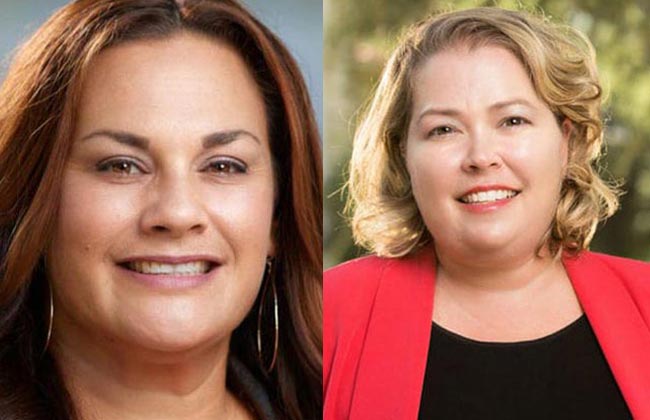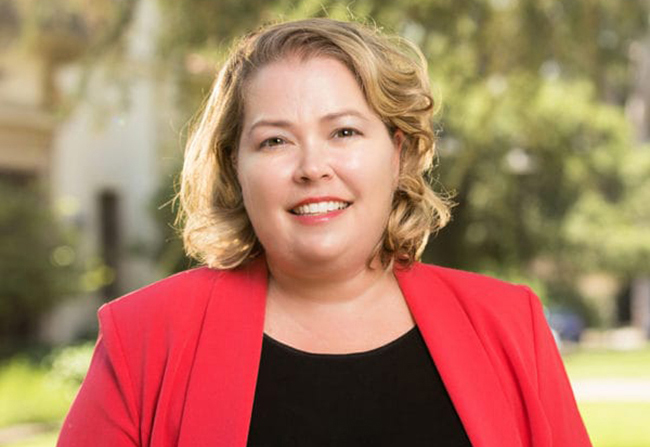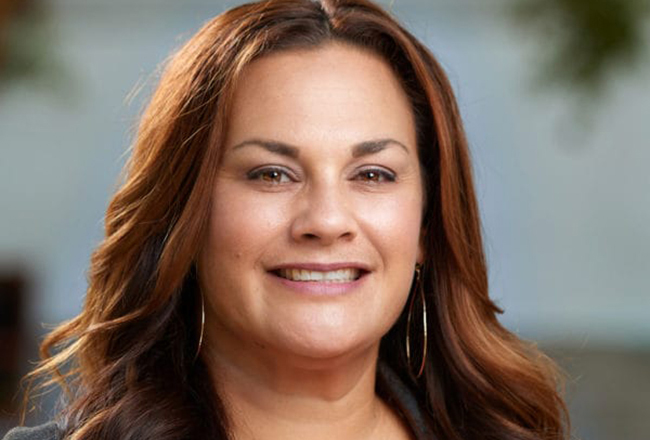What to know about education if your child has autism

(L-R) Samara Suafo’a and DeLacy Ganley of Claremont Graduate University. Photos/courtesy of CGU
By Tim Lynch | Special to the Courier
April is Autism Acceptance Month, a time to promote inclusion and connectedness for people who have been diagnosed with autism spectrum disorder and for the family and friends who support them.
The Centers for Disease Control and Prevention defines ASD as a developmental disability caused by differences in the brain that affects 1 in 36 children. These neurological differences, ranging from mild to profound, often impact social interaction and verbal communication. There is no “cure” for ASD, per se, but interventions and strategies, when enacted proactively and implemented efficiently can, in some instances, mitigate ASD symptoms. Research shows that early intervention is key.
DeLacy Ganley, above, and Samara Suafo’a from Claremont Graduate University’s School of Educational Studies shared their perspectives on students with ASD, their households, and the school stakeholders who support their needs.
Who should I talk to if I think my child has ASD?
Although studies have shown that ASD can be detected as early as 12 months, a reliable diagnosis by a trained professional can be made by age 2. (Most children, however, are not diagnosed until they are much older.) Early diagnosis is important because it leads to early intervention. We encourage households to talk to their pediatrician and/or a representative of a community early intervention program if they notice possible ASD symptoms, such as excessive temper tantrums, repetitive behaviors, or a significant delay in language and speech development that one would expect from typically developing children. Diagnosing ASD is highly nuanced and should be left to a trained professional, such as a developmental pediatrician, a child neurologist, or a child psychologist or psychiatrist.

DeLacy Ganley is the dean of the School of Educational Studies at Claremont Graduate University. Photo/courtesy of CGU
What are some of the myths about ASD?
There are a lot of misconceptions. Some believe:
- that people with ASD are exceptionally smart and have savant abilities. Others believe that individuals with ASD are not smart. Research shows, however, that individuals on the autism spectrum are unique and have a wide range of intellectual abilities.
- that ASD is a mental health disorder. It is not; it is a neurological disorder. To be clear, people with ASD can have mental health issues, but they are not one and the same.
- that ASD is caused by vaccines, emotionally distant households, or environmental factors, but research refutes these claims. It is very important to know that research has not shown that vaccines cause ASD. There is a genetic component, however, and households need to be aware that if their first child has ASD, subsequent children are more likely than those in the general public to have ASD.
- that people with ASD are predisposed to being violent, but this is an oversimplification. For example, some individuals with ASD possess a wide range of communicative abilities and might resort to nonverbal expressive language, such as gestures, screaming, or crying, to make their preferences known. Households can work with teachers, applied behavior analysts, and therapists to be more attuned to what the child with ASD is trying to communicate and can collaborate to help the child learn new and more functional behaviors.

Samara Suafo’a is a clinical assistant professor and assistant director of Claremont Graduate University’s Department of Teacher Education. Photo/courtesy of CGU
What should households of a child with ASD consider when enrolling them in a school?
Because each person with ASD is unique, their educational needs are also unique. Therefore, it is extremely important for households to engage in ongoing conversations with school personnel about the least restrictive environment for their child. In the least restrictive environment, the student with an individual education plan is educated with their same age peers without disabilities to the maximum extent possible with grade level goals that are rigorous but attainable. In other words, not every individual with ASD requires a more restrictive setting such as a special day class. Many individuals with ASD can thrive in general education classrooms while receiving additional support. Also, as part of the IEP process, households should ask about the school’s goals for their child and its experience supporting similar goals. Lastly, they should ask to be put in contact with households within the school community that have children with ASD to hear about their experiences and to network.
How can households become their child’s most important advocate?
As their child’s number one advocate, households should feel free to articulate their child’s needs and desires to teachers, doctors, and school administrators. Those who are new to the world of ASD might find it helpful to ask their pediatrician, community liaison, and/or school administrator to connect them with other parents or support groups. The emotional support and friendships are often helpful, as is the wealth of knowledge they have regarding resources, sources of information, and avenues for advocacy. We have found that most public school systems cultivate household involvement and treat households as vital partners for sharing perspectives about their child’s strengths, challenges, and motivations.
Are there legal requirements that schools meet every individual autistic child’s needs? If so, what recourse does a household have if they feel their school is falling short?
First and foremost, ongoing communication between the school and household should be established and cultivated so that all stakeholders are on the same page regarding student growth and progress. That said, public schools are indeed charged to meet the needs of all students. If there is a concern that a student has a learning disability, developmental delay, or social-emotional or behavioral struggles, an educational assessment may be requested with household consent. If it is determined that the student has a disability that adversely affects their ability to learn or access education and that the student requires special education services to make educational progress, an IEP is created. These documents are custom built for the student.
Many people are involved in writing an IEP: teachers, households, school administrators, specialized personnel, and when appropriate, the student. Household involvement is paramount, so schools will provide interpretation services for those who speak a language other than English if needed. The IEP is an educational plan designed to maximize the student’s educational experience. It is through the IEP process that goals are drafted by household and school personnel, agreed upon, and monitored. Periodically throughout the year, the student’s support team has an IEP meeting to discuss and reevaluate the plan. Goals and plans are adjusted as the student makes progress. If the student doesn’t make progress on their IEP goals, the plan is adjusted. In many cases, the school will be required to provide additional services to support the student’s growth. These additional services are offered free of charge. It should be noted that the services must be provided in the least restrictive environment.
Ultimately, if a household believes their child is not making adequate progress per their IEP or if the child is being denied their right to be educated in the least restrictive environment possible —a violation of the California Education Code — the household should articulate their concerns to the school. In some cases, the household may find it helpful to hire a legal advocate with experience speaking on behalf of the child.
How important are educational aides and/or resource teachers?
Educational aides and resource specialist teachers play vital roles in the growth and development of individuals with ASD. First, educational aides can be assigned to provide additional support within the least restrictive environment in a variety of ways, such as previewing vocabulary with a student before a lesson, reviewing course concepts following whole group instruction to clarify any misunderstandings, helping the student study for upcoming tests/quizzes, or summarizing takeaways from a lesson unit. It is important to note though, that the support provided by the educational aide is developed by the education specialist (the child’s teacher) in collaboration with the household.
Resource specialist teachers, on the other hand, have their caseload of students with varying disabilities typically in general education settings. They are responsible for collaborating with the general education teacher and other support providers in the planning, implementation, and progress monitoring of goals stated in the student’s IEP. In most cases, they are the student’s case carrier, so they are primarily responsible for communicating with households.
Who makes a good special education teacher?
Education specialists, the official title given to what laypeople call special education teachers, are incredibly helpful in meeting the needs of students with ASD. For example, when a child is having a meltdown in a grocery store, most people become judgmental and frustrated. They might think, “If I were that kid’s parent, I wouldn’t allow that to happen. That kid needs some discipline!” or even, “That kid is out of control! He shouldn’t be out and about if he can’t keep it together.” Education specialists, however, look at the same situation and understand that no child wants to be upset and that the child and their caretakers need access to tools and techniques to help prevent such meltdowns or de-escalate them when they do happen. Education specialists are often in close contact with the families of their students and will lobby for the student’s needs at district and school meetings. They truly wear capes. They are superheroes.
What would you say to someone who says there just aren’t enough resources to meet every student’s individual needs?
We would say that in addition to the law requiring us to meet the needs of all students, we also have a moral and societal obligation to meet all our students where they are. Saying that there aren’t enough resources to meet every student’s needs assumes that every student gets “the same.” Instead, we focus on providing each individual student with what they need. That’s what critical social justice is.
DeLacy Ganley is the dean of the School of Educational Studies at Claremont Graduate University. Samara Suafo’a is a clinical assistant professor and assistant director of CGU’s Department of Teacher Education.










0 Comments